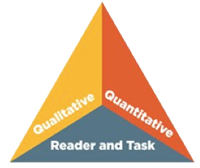Text Complexity Toolkit
To help put the right book in each reader's hands, use the following tools to implement comprehensive text complexity analyses within your instructional plans.

- Qualitative Measures
Determine if the qualitative measures of assigned books meet your differentiation needs. - Quantitative Measures
Plan for each reader's abilities to grow along a sequenced literacy continuum.
- Reader & Task Considerations
Reflect upon specific questions to match appropriate books with each reader. - Data-Driven Analysis
Use data to reveal the ranges and variety of texts and to support differentiation.
Rubrics & Worksheets
How-to Videos
Five Foundations of TeachingBooks' Text Complexity Support
Qualitative Values
Utilizing innovative rubrics that both collect and reveal crowdsourced opinions from TeachingBooks users about seven distinct elements of text for both informational and literary books.
Quantitative Values
Assigning appropriate grade bands with a crosswalk that translates Lexile levels of specific books to a half-dozen other computer-generated measures, including Fountas & Pinnell and ATOS.
Reader & Task Considerations
Offering questions that guide educators and librarians to keep these vital elements of literacy in mind.
Cultural Representation & Diversity: Optional Questions
These questions were adapted from the Southern Poverty Law Center's Reading Diversity curriculum and can be used to guide text selection and conversations.
List Analysis Reports
Supporting differentiation and selection with data that reveals the variety of texts in any booklist or collection.
Tips for Implementation
- Complete a Text Complexity Rubric together as a class, or assign students to complete a Text Complexity Rubric independently on a book they choose. Discuss the categories within and ask students why they made the selections they did.
- Use the Text Complexity Rubric as a Professional Development activity to promote discussion about text selection and differentiation.
- Reflect on different factors of complexity and consider how, for example, cultural knowledge demands may be more complex than language and why that matters. How do levels of complexity invite readers to think more deeply about a particular text?

